Early Summer Roe Deer Project 2019
23rd May 2019: I was so pleased with the images from my first visit, that I could easily have finished the project in one evening. Temperatures were a good seven degrees warmer inland, reaching 23°C and the Roe deer were just shedding the last of their thick winter coats. Grass height was still short enough to allow the easy observation of these small deer. The three babies from last year survived the winter; two bucks and one doe. The young buck was quite tolerant of me. When people wandered through the field, the buck went and hovered about the perimeter until they disappeared before returning to grazing on buttercups. Two adult does were present, but neither were pregnant. An adult buck accompanied one of the does. Possibly mistaking her availability, the buck chased the doe around the field in an unusually early display of courtship. My theory is that the doe is infertile, as she was not pregnant in 2018 either.
To avoid being bitten by pest insects, particularly ticks, I brought along a 95% Deet spray, which lasted the entire visit without reapplication. To further minimise contact with the ground, provide comfort and keep a low profile, I used a foldable camping stool for the first time. It took just 12 minutes to reach the meadow from the mainline railway station on my electric bike, avoiding the need to waste time at poorly served stops. I used to walk all the way back to the station and would routinely get home at midnight or later. Biking saves me about 2 hours.





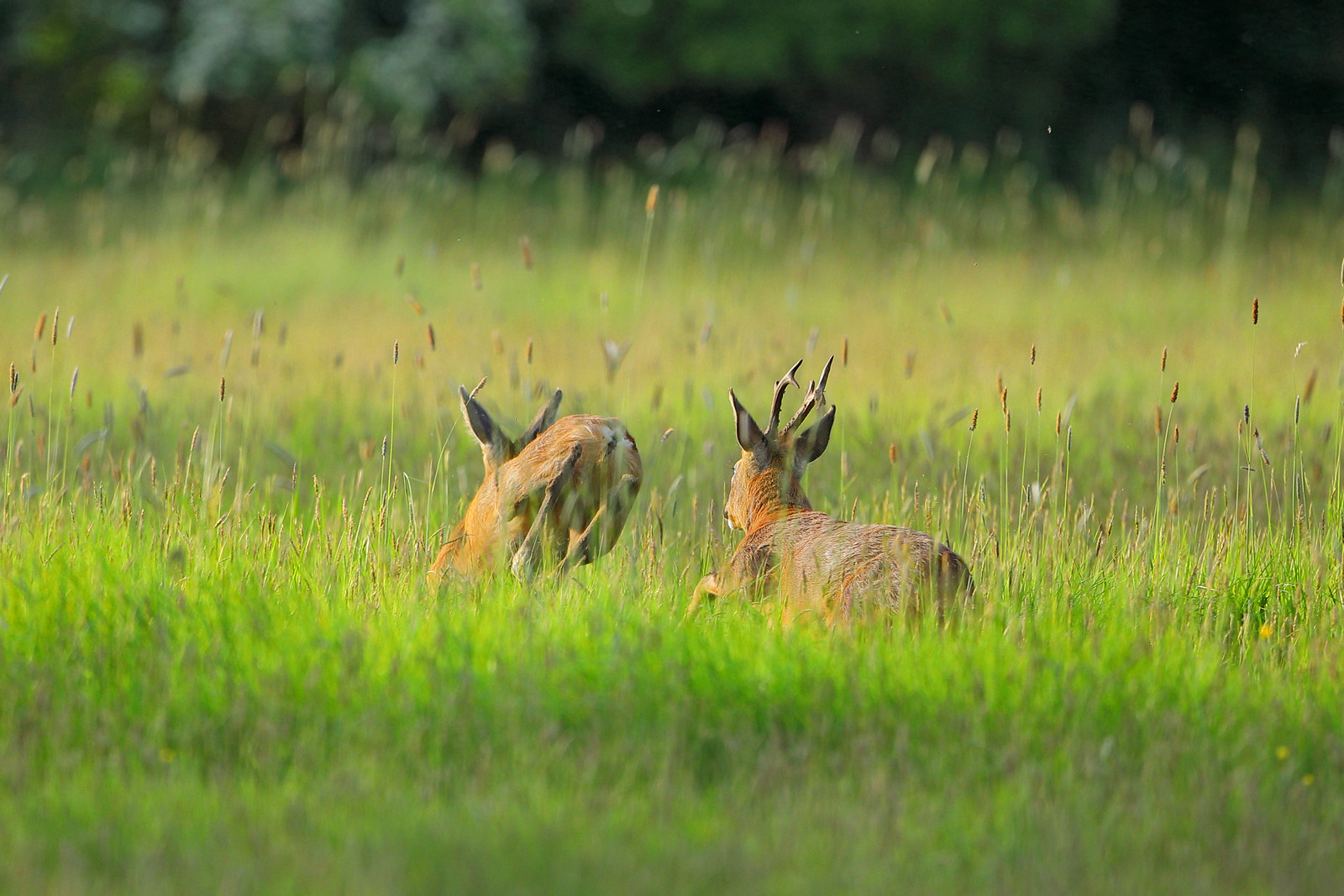
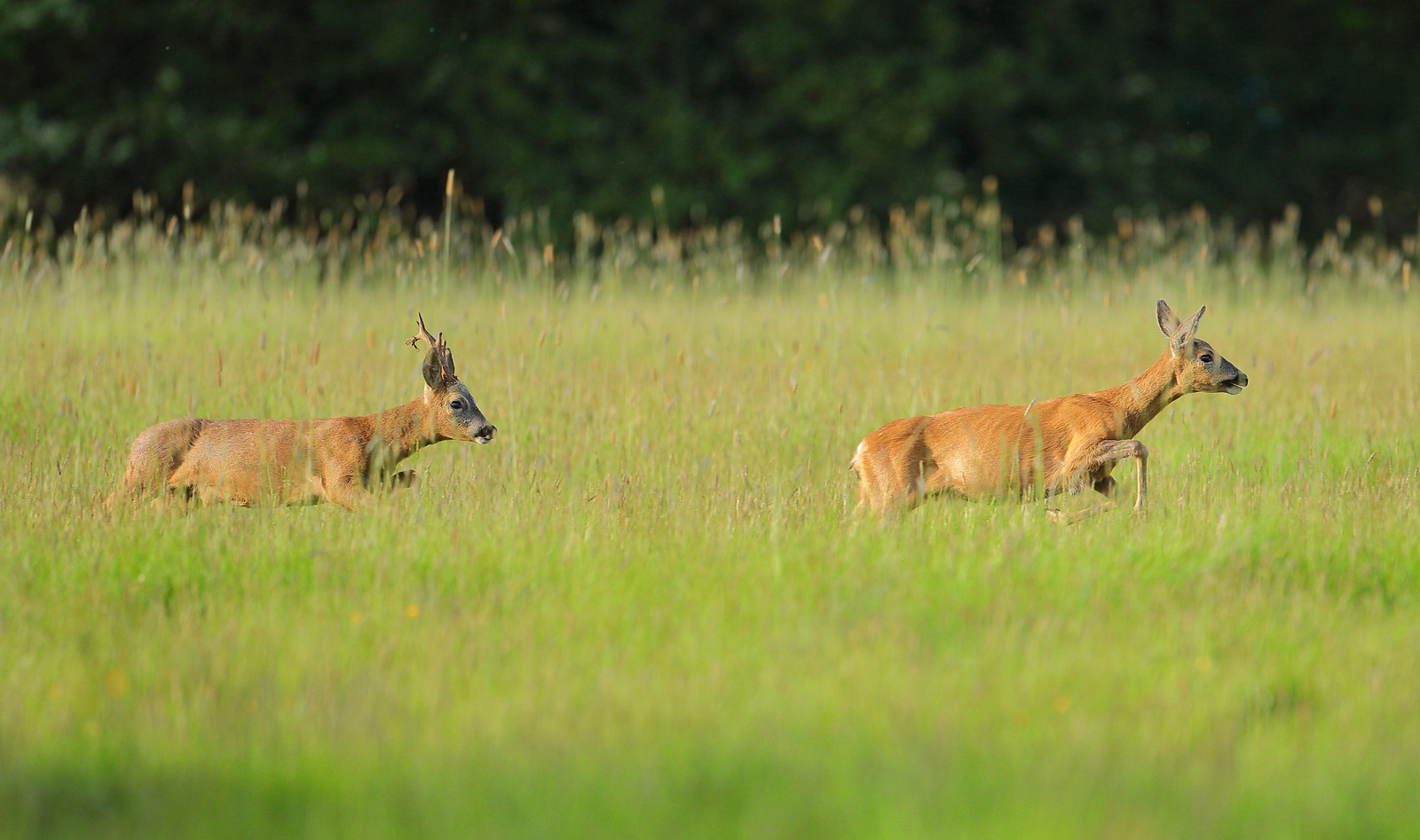
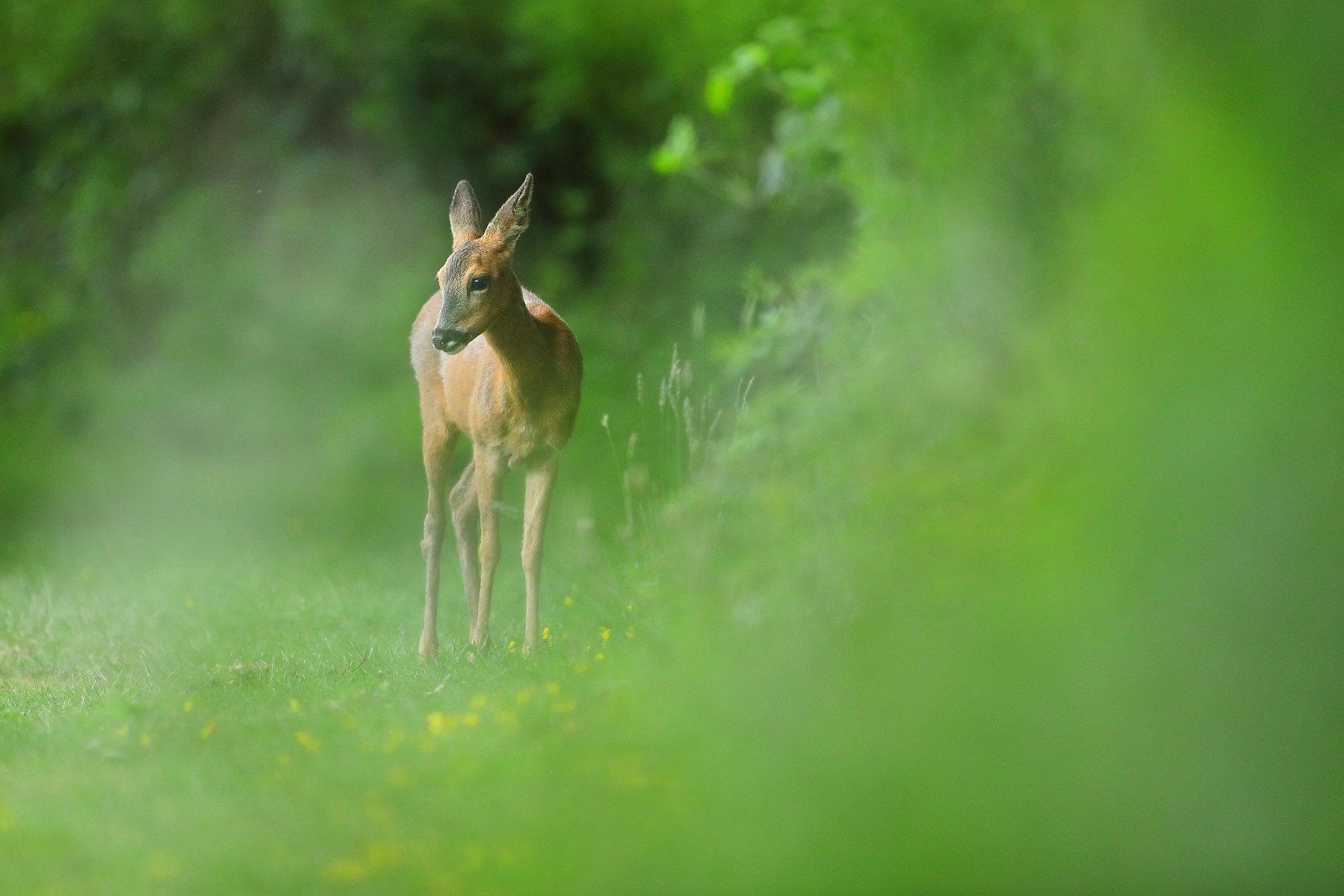
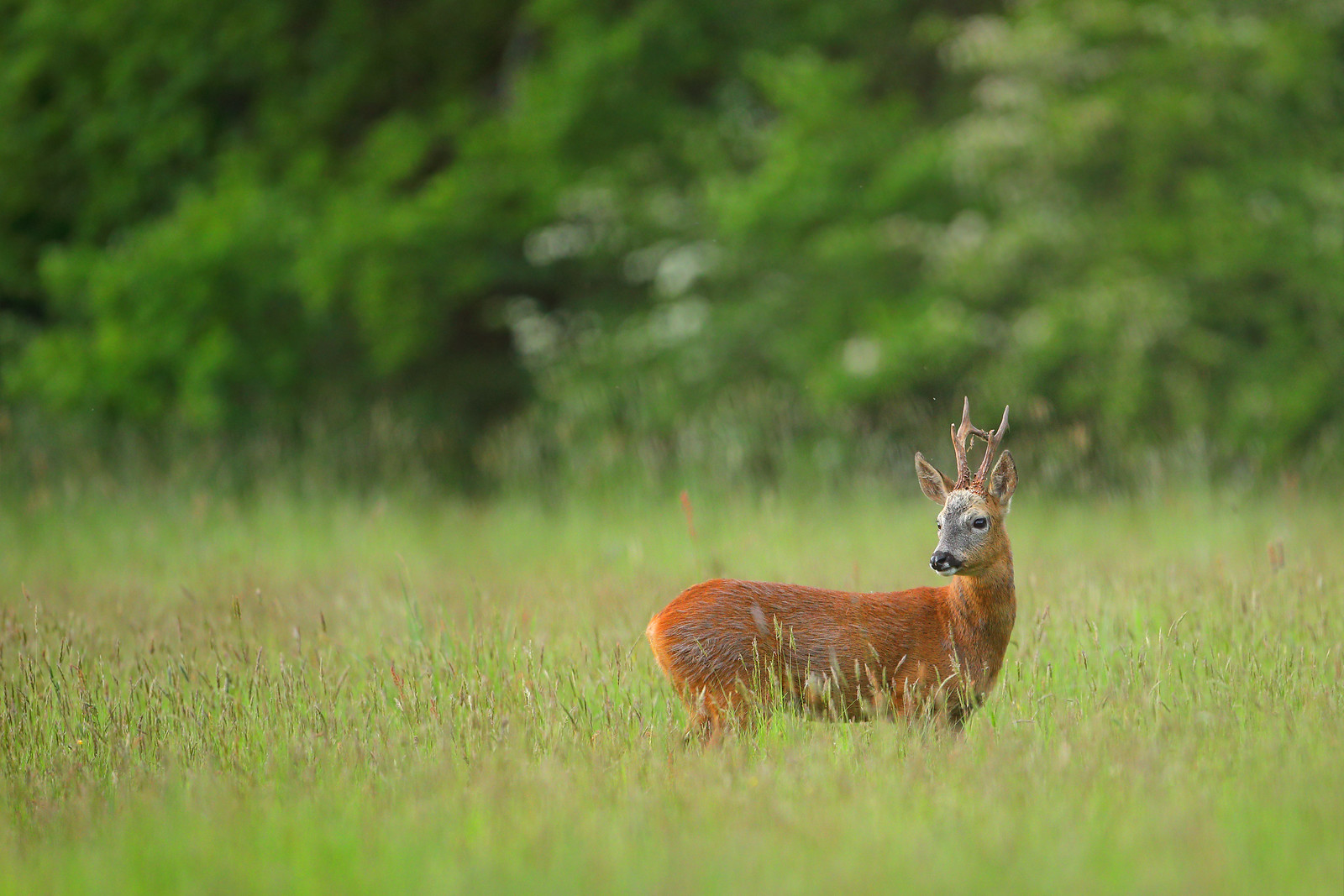
27th May 2019: Two visits to this site are never the same and as expected, opportunities were far more limited than last week. The yearling buck has a brother accompanying him, but curiously, he is still in his winter coat and velvet. Yearlings can sometimes be late to shed, due to lower testosterone levels, but the phenomenon can occur in all ages from testicular injury. The young buck seemed energetic enough, but he is much more skittish and watchful than his more laid-back sibling.
It was lovely to spot a pregnant Roe deer in the fields and I look forward to seeing her kids when they are born. She is a very gentle and tolerant doe, who I first saw in 2015, but her absence last year led me to believe she had died. If you look back at my collection on Flickr, you'll see her at various points.
It was not so lovely having a punctured rear tyre, but fortunately this incident happened close to the railway station, so I could get back to Brighton and push my bike home. This was my second puncture in 6 months and I can see myself at some point being stranded in the dark several miles from the railway station. Decathlon helped me find new tyres with a very high puncture resistance (Vittoria Randonneur), as the extra weight of the e-bike and my camera equipment increases the chance of objects piercing the tread area.
It was lovely to spot a pregnant Roe deer in the fields and I look forward to seeing her kids when they are born. She is a very gentle and tolerant doe, who I first saw in 2015, but her absence last year led me to believe she had died. If you look back at my collection on Flickr, you'll see her at various points.
It was not so lovely having a punctured rear tyre, but fortunately this incident happened close to the railway station, so I could get back to Brighton and push my bike home. This was my second puncture in 6 months and I can see myself at some point being stranded in the dark several miles from the railway station. Decathlon helped me find new tyres with a very high puncture resistance (Vittoria Randonneur), as the extra weight of the e-bike and my camera equipment increases the chance of objects piercing the tread area.


30th May 2019: I was delighted to find the doe I photographed last year had survived the winter. Like many does in the meadow, she is apparently not pregnant this year, but her twin kids born in June 2018 are alive and well (the yearling buck with a single antler and his brother still in velvet).
There are two older bucks occupying the meadow. One can be seen leaping through the air. The second was initially nervous and vocal, but he is gradually getting used to my presence, has ceased barking and will graze without bolting. There is no sign, as yet, of the two bucks from 2018 — I'm hoping that the 'Paul Newman' of the meadow and a second buck with huge antlers are alive and well. Their well-developed antlers may, however, have attracted the unwelcome attention of trophy hunters from the death industry.
There are two older bucks occupying the meadow. One can be seen leaping through the air. The second was initially nervous and vocal, but he is gradually getting used to my presence, has ceased barking and will graze without bolting. There is no sign, as yet, of the two bucks from 2018 — I'm hoping that the 'Paul Newman' of the meadow and a second buck with huge antlers are alive and well. Their well-developed antlers may, however, have attracted the unwelcome attention of trophy hunters from the death industry.
31st May 2019: What initially felt like a piece of wood underfoot turned out to be three-pointed antler dropped by a Roe buck last autumn — my first antler find in eight years of photographing Roe deer. Decreasing levels of testosterone in October cause antlers to drop from the pedicles. A scab forms within a few hours and over the coming days, a network of blood vessels begin providing nutrients to newly forming antlers under a covering of velvet. Increasing levels of testosterone cut off the blood supply in April, causing the velvet to dry out and shed, revealing fully developed antlers.
Roe deer antlers are available to purchase online, but they are usually sawn off culled bucks and therefore I would discourage anyone from financially supporting the death industry. The UK rural death industry divides the animal kingdom into two categories: game and vermin. The process of killing animals and birds is further divided along class lines. The upper and upper-middle classes pay to kill game, while the working classes are paid by the ruling classes to eradicate vermin. Any person who participates in the torture and/or killing of birds and animals for enjoyment (in the absence of any survival need) is by definition not psychologically normal. I would include within this definition, anyone who can view a healthy Roe through rifle sights and calmly pull the trigger with the same emotional detachment as someone stirring a pan of beans. There is ample video evidence of hunters and their supporters demonstrating their lack of empathy and predisposition to violence by assaulting, intimidating and bullying those who challenge their behaviour. Since much of the UK is owned by a small number of people, the issue is less about the often cited 'urban versus rural' and more about the inability of the ruling classes to abide any serious challenge to their power. The recent bullying and harassment of TV presenter Chris Packham is a good example of why people are afraid to speak out.
Roe deer antlers are available to purchase online, but they are usually sawn off culled bucks and therefore I would discourage anyone from financially supporting the death industry. The UK rural death industry divides the animal kingdom into two categories: game and vermin. The process of killing animals and birds is further divided along class lines. The upper and upper-middle classes pay to kill game, while the working classes are paid by the ruling classes to eradicate vermin. Any person who participates in the torture and/or killing of birds and animals for enjoyment (in the absence of any survival need) is by definition not psychologically normal. I would include within this definition, anyone who can view a healthy Roe through rifle sights and calmly pull the trigger with the same emotional detachment as someone stirring a pan of beans. There is ample video evidence of hunters and their supporters demonstrating their lack of empathy and predisposition to violence by assaulting, intimidating and bullying those who challenge their behaviour. Since much of the UK is owned by a small number of people, the issue is less about the often cited 'urban versus rural' and more about the inability of the ruling classes to abide any serious challenge to their power. The recent bullying and harassment of TV presenter Chris Packham is a good example of why people are afraid to speak out.
I had a lovely session with the now tolerant mature Roe deer buck in a more wooded part of the meadow, where there is plenty of cover to observe deer, without making them feel too exposed. I often wonder what the deer make of me. They have no idea that the tall, two-legged animal appearing in evening wants to show the world what wonderful animals they are. I'm sure there are quite a few pictures in this buck before my project is finished.
Earlier this year, I replaced my ageing 21 megapixel Canon EOS-1Ds MKIII with the 30.4 megapixel Canon EOS 5D MKIV. The resolution improvement is not lost on me. Most Roe deer images from the old camera were cropped to 10 - 12 megapixels. The average resolution on this current project is 15.2 megapixels, with six at 17 - 23 megapixels. Even crops from fairly distant animals come in at a healthy 10 megapixel resolution. The quieter shutter does not alert the deer, allowing them to approach within a working distance before they hear the clicking. Finally, better high ISO performance allows shooting in low light with minimal sacrifice of image quality.
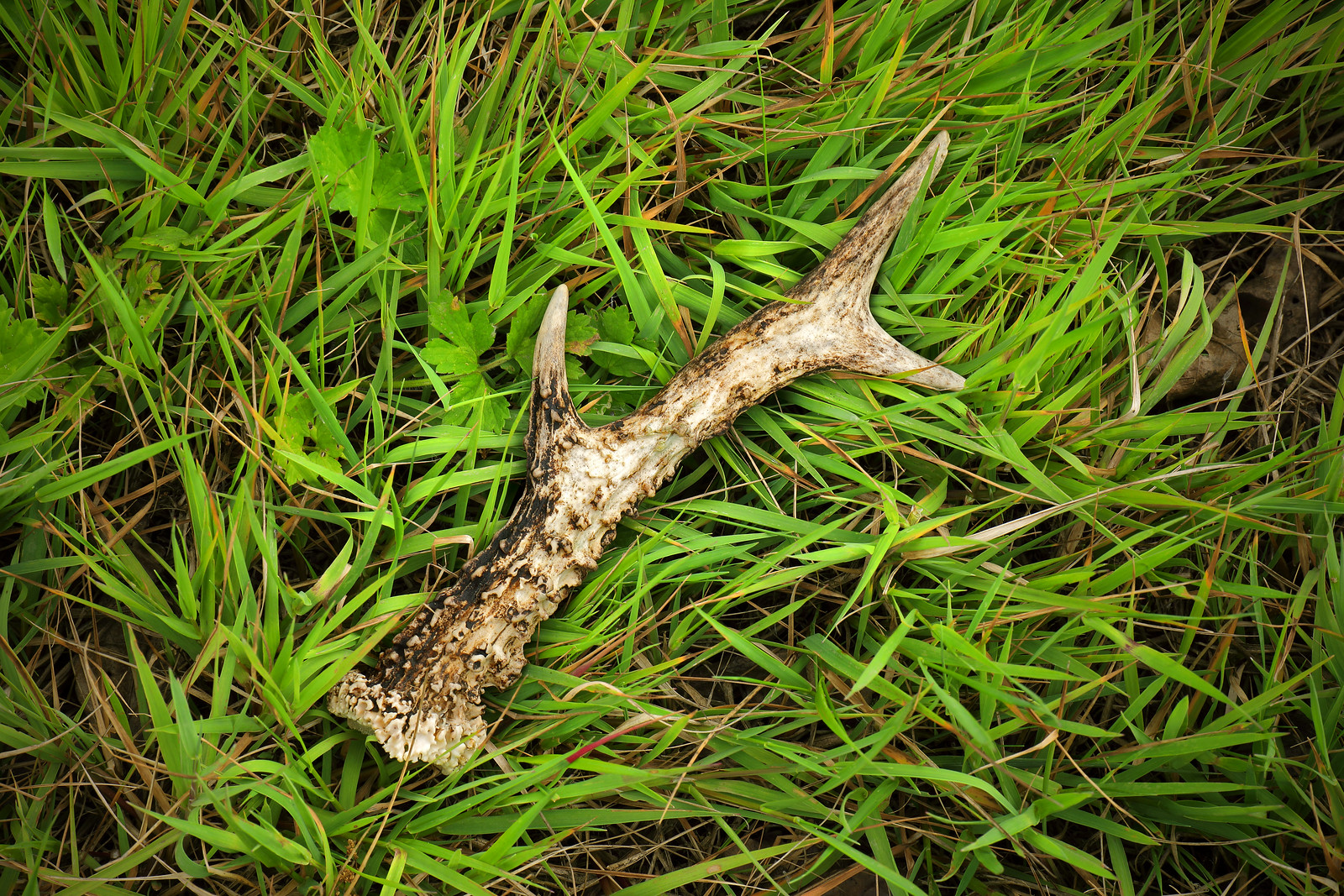
Earlier this year, I replaced my ageing 21 megapixel Canon EOS-1Ds MKIII with the 30.4 megapixel Canon EOS 5D MKIV. The resolution improvement is not lost on me. Most Roe deer images from the old camera were cropped to 10 - 12 megapixels. The average resolution on this current project is 15.2 megapixels, with six at 17 - 23 megapixels. Even crops from fairly distant animals come in at a healthy 10 megapixel resolution. The quieter shutter does not alert the deer, allowing them to approach within a working distance before they hear the clicking. Finally, better high ISO performance allows shooting in low light with minimal sacrifice of image quality.

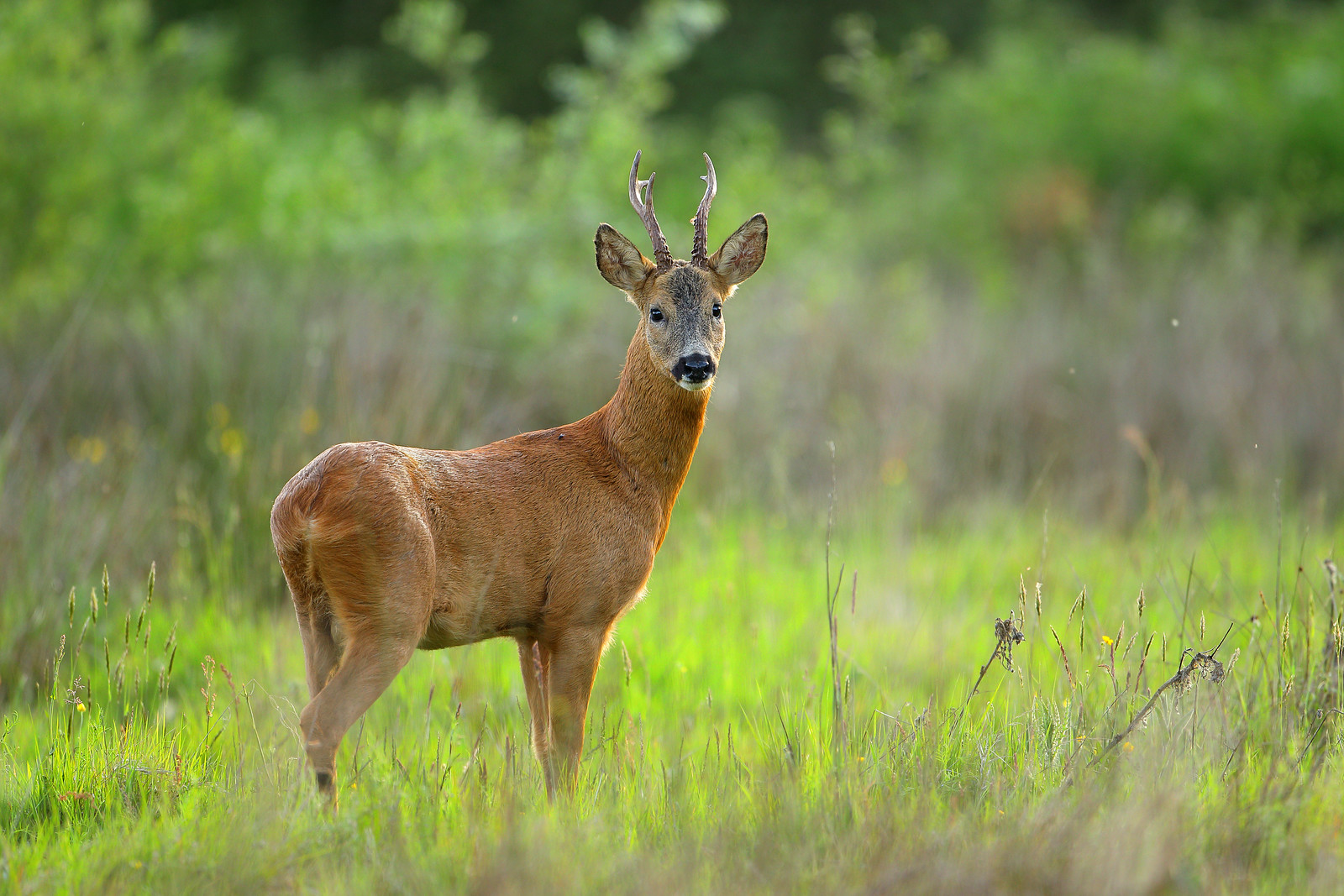


3rd/4th June 2019: The only way for me to see the deer in early morning is to stay there overnight. Despite having a tent, pillow and inflatable mattress, I found the night uncomfortable, due to heavy condensation and a general inability to sleep on anything other than a very soft bed. I watched bats gliding about as I ate my breakfast. I've never seen a person walking their dog at 04:50 before, but that person has probably never seen a photographer at that time either.
I am so used to seeing the meadows in evening sunshine, that the misty, dewy landscape came over as eerie and almost unrecognisable in very early morning. Every area has its own unique ambient sounds and the most distinctive were the Muslim call to prayer and Cockerels crowing. Here is how I captured the mature buck at 05:26, pausing to look back at the camera. I think it's a very pleasing shot of this once very vocal and melodramatic buck.
I am so used to seeing the meadows in evening sunshine, that the misty, dewy landscape came over as eerie and almost unrecognisable in very early morning. Every area has its own unique ambient sounds and the most distinctive were the Muslim call to prayer and Cockerels crowing. Here is how I captured the mature buck at 05:26, pausing to look back at the camera. I think it's a very pleasing shot of this once very vocal and melodramatic buck.

6th June 2019: My final visit to the meadows ended with the once vocal and skittish yearling buck looking much more relaxed, as he ate buttercups with me standing in open view just 30 metres away. When a Roe deer turns his back on you, take it as a compliment! The intuitive approach of sneaking up on Roe using cover only puts them on high alert for predatory behaviour. A much more effective stalking technique is to allow the deer to get used to my presence in open space. They won't waste energy bolting, when all they see is a figure standing/sitting still, making clicking noises. Notice that he is finally shedding his winter coat. I would expect the velvet around his antlers to shed next month. His brother, who is in better condition, has disappeared, possibly seeking mating territory elsewhere.
I've been very privileged to observe and photograph these wild animals, who have accepted me after initial wariness. They live in a rare viable habitat, that hasn't been eradicated in the name of agriculture and profit. But, despite my experience of carefully observing Roe, I am a source of interference and their needs must always come first. Although deer are not visible in daylight hours, they are always close by, watching the activities of regular visitors. It's now time to leave them alone. I'm sorry not to have seen any kids. There may have been pregnant does, but if there were, they did a very good job of hiding their babies in the long grass, out of harm's way.
I
hope you've enjoyed looking at my photos as much as I enjoyed taking them. The photo essay is a dying art, so please leave a comment to encourage more projects like this. Next up are the butterflies, when I hope to capture the rare Purple Emperor, so keep your eyes peeled. It's now time for me to open a few beers, relax and attend to other things.
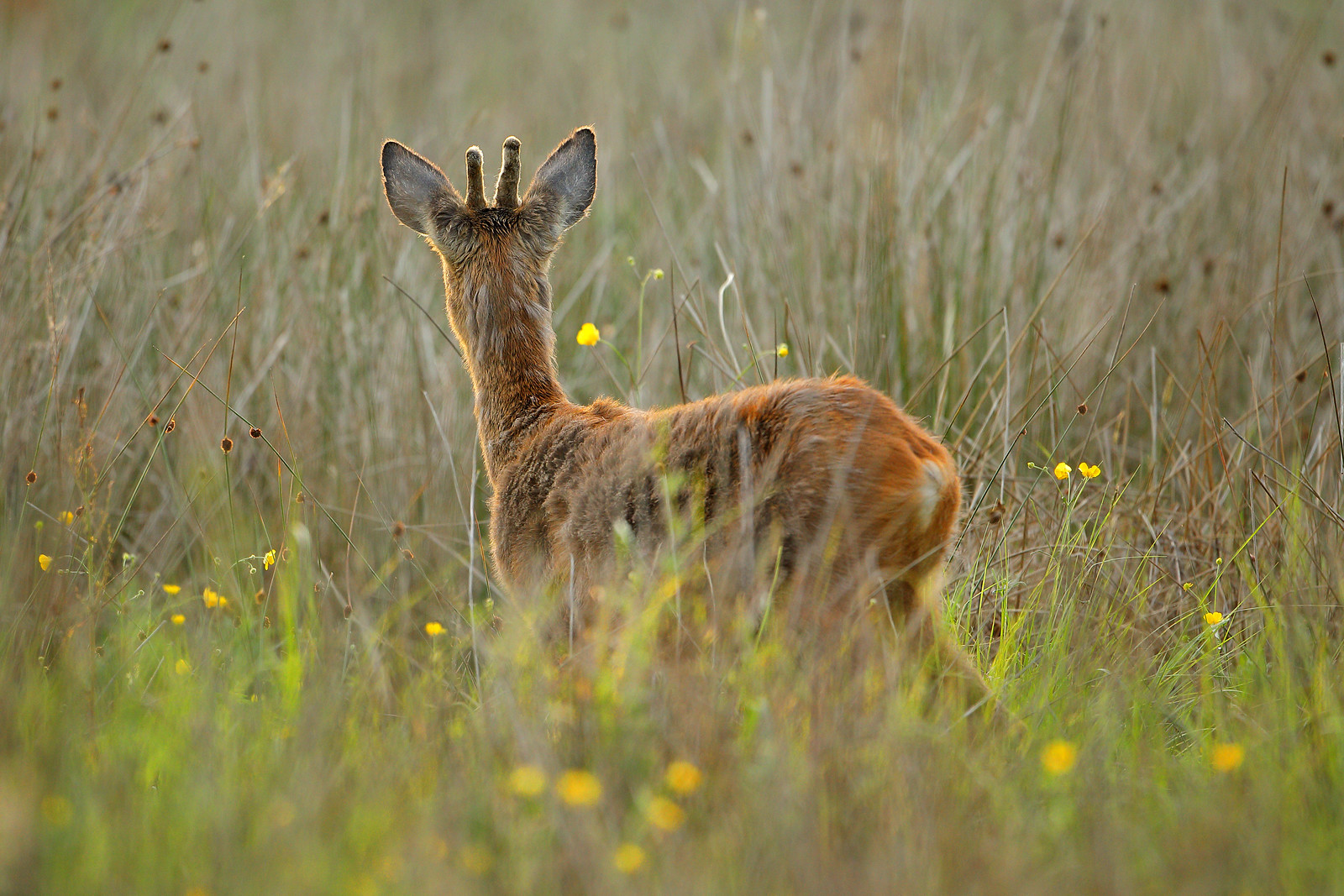


20th - 23rd June 2019: I had not planned to visit the meadow again this summer, but I wanted to make up for the disappointing June weather. The days go on forever at this time of year and we should be spending most of our time enjoying the outdoors. Temperatures on my visits were in the mid-20s, with high humidity and overcast skies.
A mature Roe buck entered the meadow to claim territory during my two week absence, which also saw days of heavy rain, thunderstorms and local flooding. The rock hard soil became boggy, with pools of water forcing deer to find alternative spots to hide away. The field always attracts mature bucks, as it contains nutritious wildflowers and low hanging oak leaves, along with plenty of cover. The field is less prone to flooding due to an incline and better drainage.
The buck is in his prime, with huge antlers. I saw him once before, on May 30th 2016. Dominant bucks like to bark continually, while grazing and rubbing antlers on tall thistles and this deer was no exception. The other mature buck has much smaller antlers and would do well not to get into a physical fight with him. He does, however, chase smaller, younger bucks for territorial purposes, including one of the yearlings from 2018 (who is now in his summer coat). Within 20 minutes of being chased, the yearling comes straight back to the spot where he was pursued, as the wildflowers are worth the risk of being on the wrong side of the older buck's aggression.
The doe seen paired with a buck on 23rd May now resides in a neighbouring field. I have not managed to spot any of her kids and as such, she may not have even given birth this year. The buck had a habit of chasing her around the field for sexual purposes and since this occurred outside of the rutting season, the unwanted sexual behaviour perhaps explains why she has moved.
A mature Roe buck entered the meadow to claim territory during my two week absence, which also saw days of heavy rain, thunderstorms and local flooding. The rock hard soil became boggy, with pools of water forcing deer to find alternative spots to hide away. The field always attracts mature bucks, as it contains nutritious wildflowers and low hanging oak leaves, along with plenty of cover. The field is less prone to flooding due to an incline and better drainage.
The buck is in his prime, with huge antlers. I saw him once before, on May 30th 2016. Dominant bucks like to bark continually, while grazing and rubbing antlers on tall thistles and this deer was no exception. The other mature buck has much smaller antlers and would do well not to get into a physical fight with him. He does, however, chase smaller, younger bucks for territorial purposes, including one of the yearlings from 2018 (who is now in his summer coat). Within 20 minutes of being chased, the yearling comes straight back to the spot where he was pursued, as the wildflowers are worth the risk of being on the wrong side of the older buck's aggression.
The doe seen paired with a buck on 23rd May now resides in a neighbouring field. I have not managed to spot any of her kids and as such, she may not have even given birth this year. The buck had a habit of chasing her around the field for sexual purposes and since this occurred outside of the rutting season, the unwanted sexual behaviour perhaps explains why she has moved.
26th June 2019: I spent the afternoon photographing butterflies at another site in West Sussex, before switching to Roe deer at 19:45, just at the time one would expect to begin seeing them in late June. Two sets of small and large hoof prints along a known route led to me a doe and her kid at the entrance to a field. At first, I puzzled at why the doe remained in situ, but the presence of her kid (sadly the tiny deer was obscured by grass) meant she could not bolt. The deer at this site are fairly tolerant and she is possibly not one for bolting. I've coined the term roemainer for any Roe deer that remains to be photographed, while showing little or no alarm towards the observer. I encountered another roemainer in a neighbouring field, a young buck with no antlers, despite having two pedicles.


Keywords: wildlifephotography deer naturephotography canon 500mm brighton sussex wildlife climateemergency globalwarming globalheating extinction extinctionrebellion

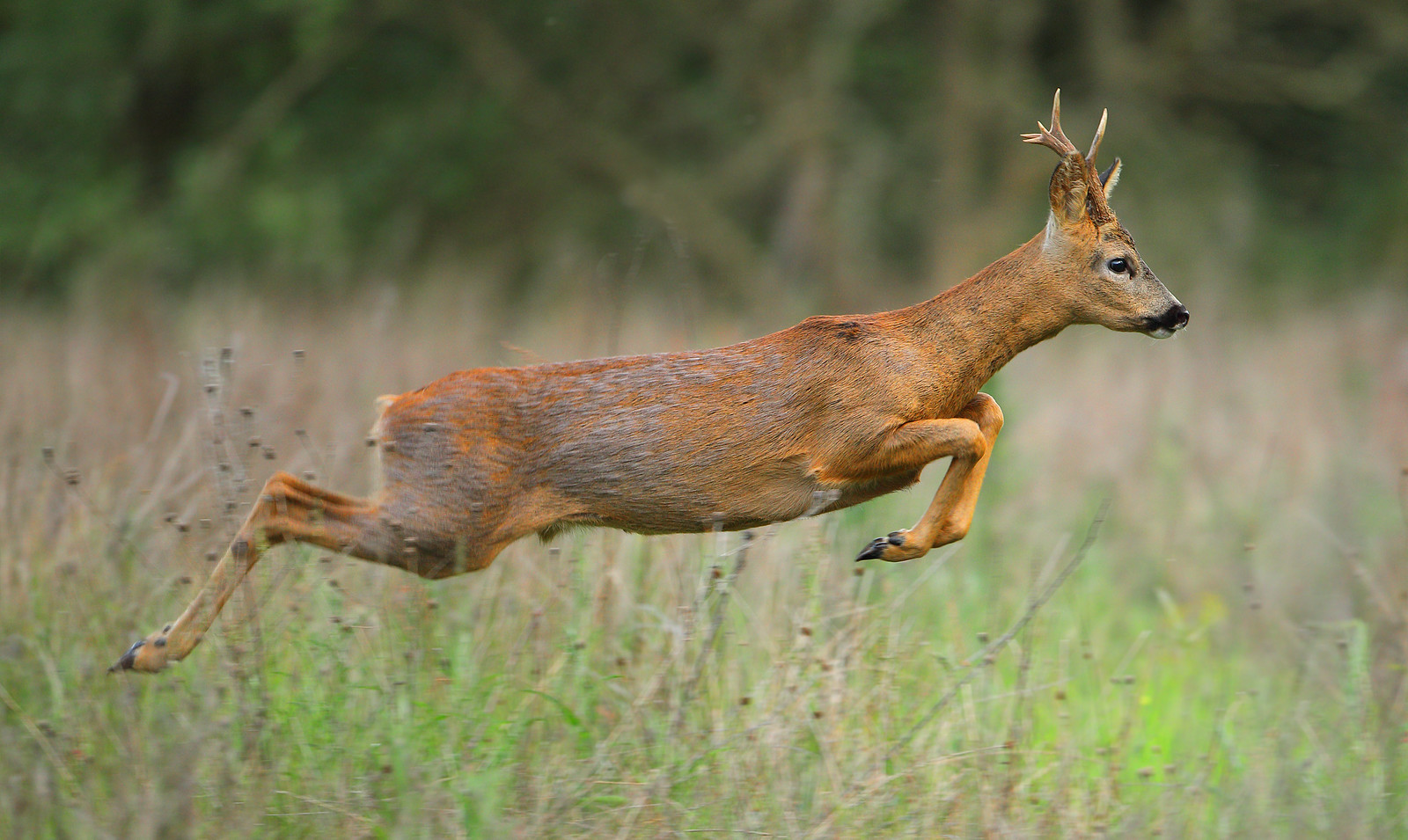


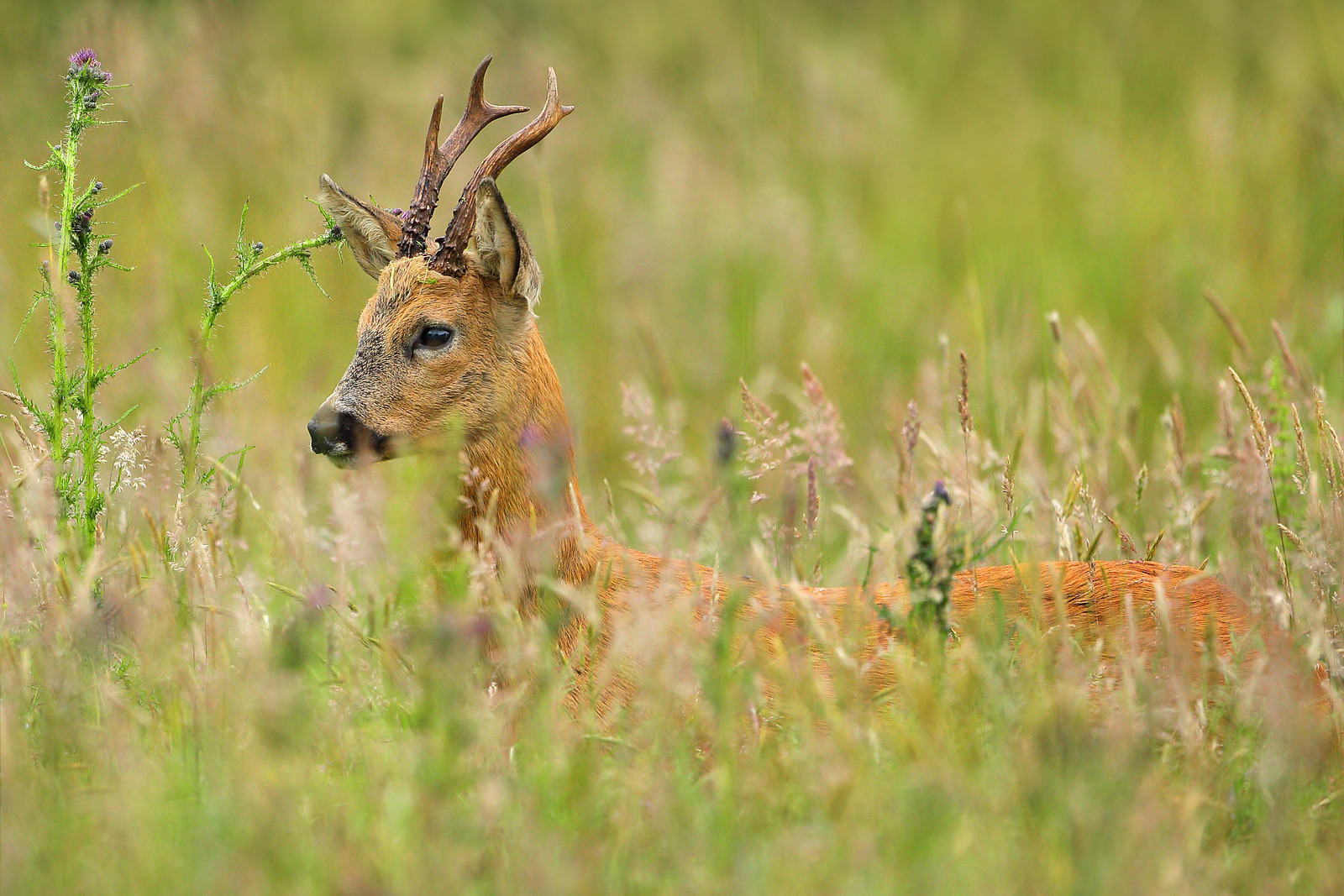


Comments
Great to read another one of your blogs, especially when it's about roe deer. I agree with what you said about photographic essays, they're certainly less common than the standard, photograph / brief comment format that we normally see on social media.
Oh yes, that reminds me: I just thought I'd let you know that for some reason or other, I seem to unable to find your Facebook page.
Anyway, very much like your photographs on this blog and I bet you were pleased when you found that antler! They're not the easiest thing to find are they?
Keep up the hard work with the roe deer, Alan - I really like it when I check your website and see more of your work.
All the best,
Mark
I don't have Facebook or Instagram any more. It's regrettable that I haven't discovered a good way to alert people about new posts, but those who are genuinely interested will always seek me out. I wasn't happy with the quality of interaction on social media, which I feel is making people into passive voyeurs, who look, but don't want to get involved. People just scroll down their screens, tapping like and instantly forgetting. On Instagram, there was too much liking to get likes back or following/unfollowing to build audiences. Facebook and Instagram are designed to be addictive; it's all too easy to get caught up in accumulating likes and then begin worrying if your latest upload hasn't achieved your benchmark metrics. The heavy image compression, particularly on the Facebook app, made my photos look like thumbnails enlarged 20 times. At least on Flickr, original quality is preserved. I'd recommend joining Flickr to anyone who wants to keep up with my latest work. I have some really good wildlife photographers following my work, but unfortunately there is still some degree of faving and not bothering to comment.
I'm tempted to buy a used Canon EF 1.4x MKIII extender. Alex Witt recommended it over the cheaper MKII. Park Cameras will let me try it in-store and view the RAW files before buying.
Have you been to your Roe deer sites recently? I'm keen to see what's been happening down in Dorset.
Best wishes,
Alan.
Thanks for your reply.
I didn’t know you and Jules both used that roe deer site. The only thing I know about Jules is that he’s moved to London and maybe he’s running workshops with clients photographing roe. Hopefully, he will both put up a blog in the not too distant future, and all will be revealed.
Over here, as of this morning, nearly all the local mothers-to-be have, indeed, given birth. Like you’re experiencing, the long grass makes things rather challenging when it comes to location and making decent observations and photographs.
The bucks have been fighting recently, but making a photograph of them is nigh on impossible, since they plunge their heads right down to ground level when they’re pushing and shoving against each other. You can see them posturing and parallel walking etc, but getting a clear view of them going head-to-head, is well beyond me. To be quite frank, I really don’t like to see them fighting. When tussle goes on for a long time and it’s a really serious battle, the losing buck sometimes screams and that sound goes right through me – I hate it. I know that probably makes me a bit of a wimp, or soft, but seeing two deer trying to kill each other is not my idea of fun. I remember a couple of years ago when a defeated buck was turned right over onto his back, legs flailing around in the air, etc…. Luckily enough, just as the dominant beast disengaged his antlers from the defeated male’s head, presumably to deliver a body blow, the other male managed to get back onto his feet / hooves and make his escape. But the winner’s head was left with blood running down the side of it, though; not a nice sight.
I’m afraid I can’t offer much in the way of knowledge about the Canon 1.4X converter, I’ve haven’t used one, but I’m sure all the Canon gear is very good.
When it comes to social media, I’ve found it to be a good vehicle to view other people’s work, however, I see where you’re coming from regarding its addictive nature. It is so easy just to skim through the news-feed and Like and forget. But nonetheless, you can ‘meet’ some interesting people on there, yourself included, so in that way, there have been a lot of personal benefits. As you know, I just take photos to increase my understanding of the roe and show my students the latest comings and goings in the world of the deer. But later in the year, I do, at this point, intend to put a couple of things on Facebook, etc…. that may be of interest to anyone who wants to know more about this wonderful species of deer.
As well as re-reading your most recent blog, I will be looking out for your future work.
All the best,
Mark
The Roe bucks can be very aggressive towards humans. On Wednesday evening, a mature buck who looked like butter wouldn't melt in his mouth back in May ran at me, barking, stomping and rubbing his antlers on vegetation. His dander was up for several minutes, before he finally stopped behaving like a thug on a Friday night. I've never seen a live Roe buck fight, but I watched a horrible video of a terrified buck trying to escape under a fence, before being badly injured. He had to be shot. Some people would criticise me, but I think I would have intervened and put a stop to it, as the buck had already given in and there was no need for the winner to injure him. We intervene to help injured and stricken wild animals all the time, so I have no issues with doing what comes naturally to me. Empathy for the suffering of others is what sets (most) humans apart from other animals. I could have just left the many animals and birds I've rescued to die and provide a meal for a fox, but my interventions were just as natural as Roe bucks trying to kill each other over a mate. Maybe our starving ancestors would have seen a free meal in the injured Roe buck, but abundant food and a secure lifestyle frees up modern humans to help other animals, rather than act on our baser instincts.
I've found your observations and research about Roe deer ecology on www.aboutdeer.com extremely interesting and informative. Thank you so much for taking the time to write it. I will put your knowledge to practical use in future. I feel like I've obtained an extra piece of camera gear with that information. I should find it easier to predict, track and observe Roe deer behaviour much better now. Your information answers why sightings at my two Roe deer sites varies throughout the year, as deer move out to locate food or form groups to guard against predation.
I think I know what your Facebook announcements are going to be about - your upcoming photo book! I will, of course, be ordering a copy.
Best wishes,
Alan.
Thank-you very much for your comments about the new website. As you’ve seen, the site not properly done yet; I will change a few things here and there, as well adding a few more photos, etc…
It has been created to give anyone with an interest in roe, some basic biological knowledge of the deer, whether they intend to photograph them, or more likely, because they might see them in the garden and the countryside, they just want to know a few details about the species itself.
With regard to the book, it is not be any stretch of the imagination, doing to be a photography book. There are certainly photos in it, but it is more of a story book about a certain group of roe, told by pictures and words, rather anything instructional. It’s still quite a while before the whole project will be completed, and I would seriously caution you to keep any expectations very firmly in check, if you know what I mean!
You’re so right — roe can be aggressive towards human beings. I can just imagine how that buck behaved towards you last week. Maybe because the roe is a relatively small deer (at least in comparison to red and sika) that people think that the species is always going to be shy, and will be inclined to run away. With your experience though, you’re obviously going to minimise danger to yourself and the deer.
I take your point about intervention in the case of the two bucks fighting, and where one of them had already given in. Professional and highly knowledgeable wildlife filmmakers have been known to take action on occasion.
My limited experience would suggest that early morning and late evening are probably the best times to see bucks fighting. I have seen hostilities break out during the heat of the day, during the early part of the rut, but early morning (ie within an hour of sunrise) is the favourite. As you can imagine though, trying to take photographs of them is a problem; the actual clash of heads normally lasts in the order of seconds, they’re moving around a lot (with their heads, as well as bodily moving around rapidly), the light level is low and they invariably put their heads down in among the stems, etc… And then there’s the problem of location; the bucks don’t advertise their presence, unlike red, fallow and sika, when they’re predisposed to fighting. Sometimes, the adult bucks will just appear out of the blue. A couple of times, I’ve just been sat there, all alone in a field and then all hell breaks loose as two beasts materialise from the bushes.
Although it wasn’t my initial intention, I may try to put something on the website explaining to others one or two things that a fellow deer watcher might find helpful when it comes to observing roe deer behaviour in the field, and sometimes trying to photograph it. Because as you know, seeing it is one thing, but photographing it can be a nightmare.
Right, got to be off now.
All the best,
Mark
PS. For future messages, maybe I could suggest using e-mail?
With big interest I have been reading your blog on Roe deer (as well as the one from Mark Nicolaides). I am following about 6 Roe deer at the same local site since March now. Doe with to fawns, another doe, a young buck and an older one. I can see them every other visit early morning. Let's say once a week. It's my morning walk as a beginner photographer.
I am trying to make a project out of it. But have tried two approaches without much success. First one is to walk around to spot them, off course they spot me before I see them. They stare at me from a distance. I kneel down, stay still, most of the time I even don't take a picture. But even then after two or three minutes they walk away and hide in woodland. Second approach is to hide myself. Mostly I don't see any off them, whenever I have success they are very close, spot me and they ran off in panic making their typical alarming sound.
So far my attempts to take these beautiful frame-filling pictures like you both have are unsuccessful. By the way my gear is 90D and canon 100-400ii.
Anyway for the moment I don't give up, but wonder what I do wrong... Any advice from you specialists would be nice...
I would suggest you find another Roe deer site with regular human visitors. The site I visit is a nature reserve close to a town. People visit throughout the day, so my presence will not come as a surprise to any deer. Visitors are well-behaved nature-lovers, therefore the Roe will not associate human presence with danger. I let the deer see me, as they hate surprises and within minutes, they return to normal activity. Don't ever try to hide from Roe deer! This will be interpreted as predator behaviour. Let them see you are not a threat.
Do you use a monopod or tripod? At 400mm, physical stability is a good idea for sharpness and preserving the composition.
It would be good to know which country you are photographing Roe deer in? All the best, Alan.
Thanks for the reply.
I struggle to take clean pictures of the deer. I adore this lovely animal and even if walking home without a picture at all (like this morning) I am exciting if I can only see them as well. But hey, photography is my hobby and I would like to get a good photo once in a while.
My name is Geert and I live in Belgium. The site I visit is close to a small town and since the COVID-pandemia it is used by hikers or joggers. So, it's certainly not the first time deer see human behavior there.
I like to use this site since it is 10 minutes walk from my house.
To describe the site, you got about 4 meadows of about 40 by 40 meters roughly, some corn fields and the rest is covered with woodland. When I quietly and gentle walk around the corner of a woodland I can see them very often on the meadow. But after staring at me they often leave quickly. I cannot see their normal behavior. I take the tips from you and Mark and wear same clothing, kneel down, wear gloves, etc... Not a chance.
Other problem I face is that at 40 mm with the 400mm lens and the bad light conditions in these early morning hours, ISO goes up to about 3200, sometimes higher and this at a shutterspeed of 1/320 or so. Because they are so far away, I have to crop and this leaves me with unsharp and noisy image. I'll try to set up my tripod next time...
I hope to follow them the whole year round and maybe longer.
I enjoy seeing your pictures and even more your story behind it. Saw that you did the same in 2020.
If I can find your email adress on your blog I can maybe send you one of my pics.
All the best
Geert
I've send you an email.
During the day, there's hardly a chance you would see them in the open. In the woodland it's too dark and they would feel hunted. I certainly don't want to scare them off.
Have fun with your photography
Regards
Geert
The availability of food affects the presence of deer and how long they stick around when seen. Between May and July, there are plenty of wildflowers and lush green leaves to eat. I noticed the same with butterflies. Once they become preoccupied with food, they take more risks and ignore people. However, once the food supply dies off, the deer have to find somewhere else. A reliable site in summer may not be a reliable site at any other time of year. Do you think food supply affects the presence of deer at your site?
The best way to overcome noise issues to to replace your camera, if you want to and can afford the expense. I use the full-frame Canon EOS 5D MKIV, which I am paying for over 2 years with interest-free credit. I'm happy with the performance at ISO 3200, but wouldn't go any higher than that for wildlife. In most cases, if you are trying to shoot any higher than ISO 3200, perhaps that means it is too dark anyway and it's time to head home. Or in my case, cycle 26 miles in the dark!